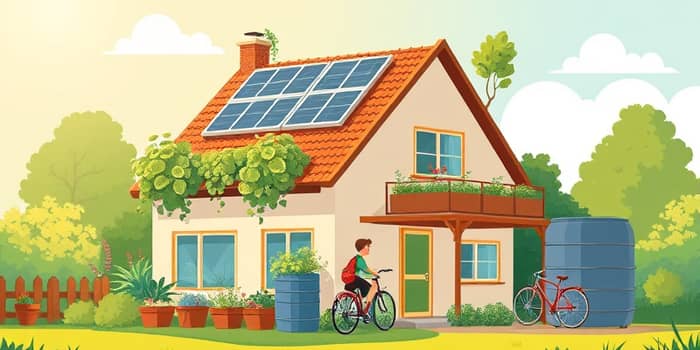In an era of rising costs and global uncertainty, the idea that sustainable living demands extra spending is a powerful misconception. In reality, adopting an eco-friendly lifestyle can unlock significant cost savings over time while nurturing a healthier planet.
By learning to repurpose, repair, and conserve, households can transform daily choices into economic advantages. This comprehensive guide explores how simple shifts in habits yield powerful results for budgets and the environment alike.
The Cost Myth of Sustainable Living
Many believe that eco-conscious products and green technologies carry a premium price tag that outweighs any benefit. Yet, research shows that the very practices people shy away from often pay for themselves through reduced waste, lower bills, and extended product life cycles. Green habits emerge naturally when consumers face inflation, prompting them to shop second-hand, repair what breaks, and minimize unnecessary purchases.
Rather than adding expense, sustainable living reframes spending priorities. It encourages investing once in durable goods, adopting minimal-waste strategies, and pursuing energy and water conservation tactics that slash recurring bills.
High-Impact Money-Saving Practices
From the kitchen to the driveway, practical eco-friendly measures deliver tangible benefits. Simple adjustments in daily routines accumulate to deliver simple everyday habits and routines that drive down household costs.
Simple actions, such as meal planning and proper portion control, can reduce food waste and keep as much as $1,500 in your pocket each year. Upgrading to LED bulbs, sealing drafts, and installing smart thermostats cuts energy bills by 10–20%. Turning off taps, using low-flow fixtures, and running only full loads of laundry or dishes lowers water costs without sacrificing comfort.
Strategic investments—like residential solar panels—offer a strong return. Panels have dropped dramatically in price and can repay installation costs in under a decade through significantly lower utility bills.
Broader Economic and Technological Trends
On the global stage, corporations and governments are recognizing that doing more with less yields long-term financial resilience and growth. Businesses embracing circular economy principles—repair, reuse, recycle—report healthier bottom lines and stronger customer loyalty.
Meanwhile, rapid innovation and decreasing costs in green technologies broaden access. Smart home systems automate energy management, next-gen renewables ramp up capacity worldwide, and digital platforms support local sharing, rental, and upcycling initiatives. Together, these advances reinforce a shift toward resource-efficient living with minimal financial burden.
Practical Tips for Everyday Consumers
Embracing sustainability doesn’t require a complete lifestyle overhaul overnight. Start by reevaluating your current possessions and extending product life cycles effectively. Repair broken items, buy second-hand, and choose quality over quantity.
- Plan weekly meals and freeze leftovers to cut food waste.
- Seal windows and doors, switch to LED lighting, and set appliances on timers.
- Install low-flow showerheads and faucets to save water.
- Consider public transit, cycling, or carpooling before purchasing a second vehicle.
- Explore local repair cafés and community tool libraries for low-cost fixes.
These small steps deliver a measurable impact on household budgets from month to month. Over a year, combined savings can rival or exceed the cost of more visible upgrades like solar panels or electric vehicles.
Looking Ahead: Policy and Global Impact
Countries around the world are driving change through incentives, subsidies, and regulation. International agreements such as COP28 and COP29 push for higher renewable energy targets, with the EU aiming for 42.5% renewable power by 2030. China is projected to add 60% of global renewable capacity by the same year, fueling further economies of scale and price reductions.
As policies evolve, consumers benefit from rebates on energy-efficient appliances, tax credits for solar installations, and grants for electric vehicle purchases. These programs not only reduce upfront costs but also create a ripple effect that supports supporting community businesses and economies as local installers, manufacturers, and retailers adapt to demand.
In embracing eco-friendly practices, individuals and households unlock significant cost savings over time while contributing to global efforts against climate change. By aligning personal finances with environmental stewardship, sustainable living becomes the smartest investment you can make—both for your wallet and the planet.
References
- https://www.arbor.eco/blog/sustainability-statistics
- https://www.stern.nyu.edu/experience-stern/about/departments-centers-initiatives/centers-of-research/center-sustainable-business/news-events/news-insights/cnn-25-sustainable-products-will-actually-save-you-money-2025
- https://www.stantonchase.com/insights/blog/profit-despite-politics-how-sustainability-continues-to-benefit-businesses-in-2025
- https://www.ecoenclose.com/blog/sustainability-decisions-in-2025
- https://www.ecogreenvision.com/blog/sustainable-living-trends-2025/
- https://www.triplepundit.com/story/2024/sustainable-living-cheaper-affordable/796716
- https://www.unicefusa.org/stories/guide-sustainable-living
- https://www.neste.com/en-us/news-and-insights/sustainability/sustainability-trends-of-2025










